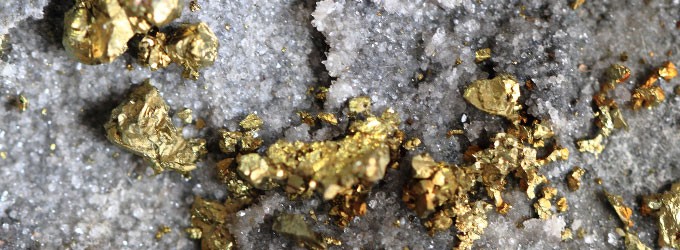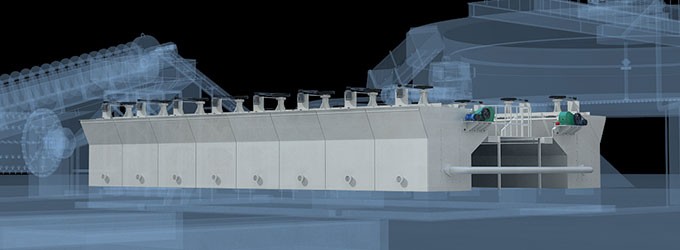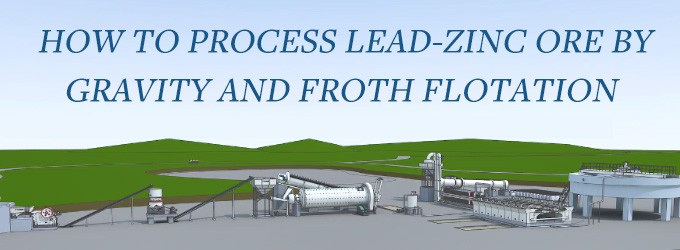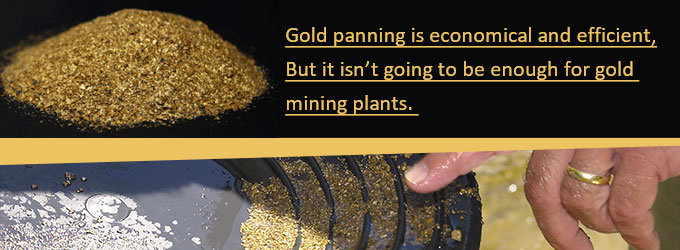Gravity concentration (also known as gravity separation or gravity beneficiation) is one of the oldest mineral beneficiation processes. From 500 BC until today, it is especially suitable for ores that are difficult to be beneficiated using froth flotation.
What is gravity concentration?
Gravity beneficiation is based on the difference in mineral density and particle size, by means of fluid power and mechanical force, the minerals are stratified, so as to obtain products with different densities.
The gravity separation method is suitable for processing materials with large density differences, such as non-ferrous metals (gold, copper, tin, lead-zinc, platinum), ferrous metals (iron, manganese), rare metals (tungsten, thorium, zirconium, niobium, tantalum, etc.), beach sand, and coal separation.
The common gravity concentration methods mainly include 5 types: shaker, jigging, chute, dense medium, and centrifugal beneficiation.
1. Shaker beneficiation
Shaking table beneficiation uses the inertial force generated by the reciprocating motion of the bed surface and the flow momentum of the thin water layer on the slope to separate minerals of different densities from each other.
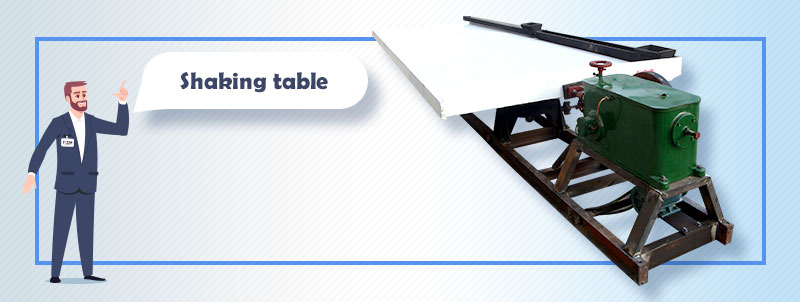
According to the selected particle size, shaking table is divided into an ore shaker and a slime shaker. The ore shaker sorts the materials of 3-0.2 mm, and the slime shaker sorts the materials of 0.2-0.037 mm.
What is the application of shaking tables?
- Shaking tables are common equipment for separating fine-grained ore in gravity concentration plants.
- Separation of gold ore and gold placer by shaking table is very popular in Africa.
- For sorting tungsten, tin, tantalum, niobium, chromium, iron, manganese, and precious metal ores (platinum group metals).
- They are also used in coal slime separation in the opencast coal industry.
What are the pros and cons of shaking tables?
Advantages
- The enrichment ratio of ore dressing (the ratio of concentrate grade to raw ore grade) is high, up to 100 times or more.
- The shaker can sort minerals of various qualities at the same time to obtain high-grade concentrates and discard tailings.
- The ore is fan-shaped on the bed surface, which is convenient for observation and adjustment.
Disadvantages
- The equipment occupies a large area and consumes a lot of water.
- Low productivity, the processing capacity of the standard shaking table (4500×1830) is 0.12-2.2 t/h.
2. Jig beneficiation
Jig beneficiation refers to the process in which materials are layered according to density in the variable speed medium flow of vertical lifting to achieve the separation of different minerals.
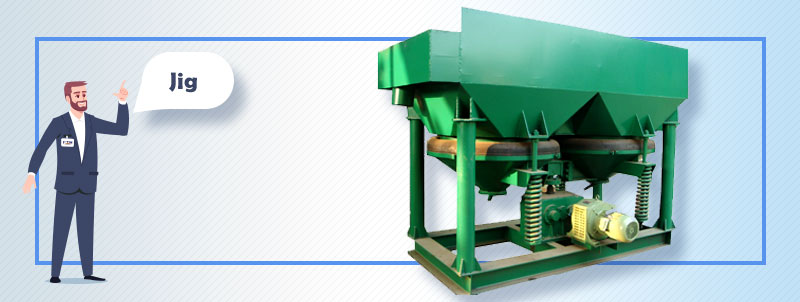
Metal ore concentrators are mostly hydraulic jigs. The feed particle size can reach 50 mm, and the recovery particle size can be as low as 0.2-0.074 mm.
What is the application of jig machines?
- Jig beneficiation is the main method for processing coarse and medium-grained minerals, and it is most suitable for separating 18-2 mm ores.
- Recovery of valuable heavy minerals such as gold, tin, tungsten, platinum, diamonds, sapphires, etc. from alluvial or placer gold.
- Processing of iron ore, manganese ore, chrome ore, or metal ore containing niobium, tantalum, titanium, and zirconium.
What are the pros and cons of jig machines?
Advantages
- Jig machines are known for their high separation efficiency.
- The process operation is simple, and a certain final product can be obtained in one sorting.
- Compared with traditional gravity separation equipment, the water consumption of jig machines is reduced by 30%-40%, and the floor space is reduced by 1/3.
Disadvantages
- Jigs are less efficient for very fine minerals. Because some fine particles cannot settle accurately in the pulsating water flow.
- The separation efficiency of jigging coal preparation is lower than that of dense medium coal preparation.
3. Chute beneficiation
Chute beneficiation is to feed the ore slurry into the chute with a certain inclination angle, and use the pulsating water flow flowing along the slope to make the ore particles stratified according to the density.
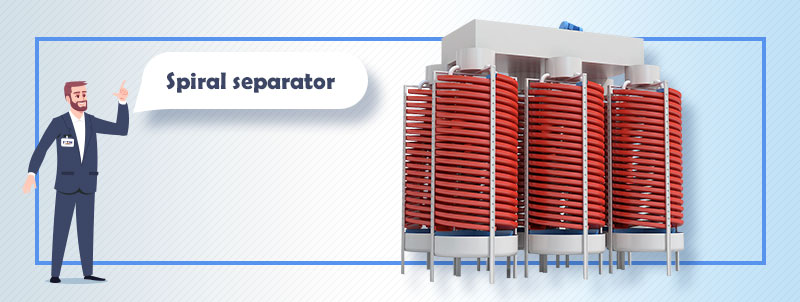
The spiral chute is the earliest gravity beneficiation equipment, and the feed particle size is between 40-0.019 mm.
What is the application of spiral chutes?
- Mainly used to process heavy mineral placer deposits, such as monazite, zircon, gold, coal, ilmenite, chromite, rare earth ore, and rutile deposits.
- Sludge chute is the most widely used to process microfine (-0.074 mm) low-grade placer of tungsten, tin, gold, platinum, and other rare metal ores.
What are the pros and cons of spiral chutes?
Advantages
- Spiral chutes occupy a small area and have a large production capacity per unit area.
- Simple equipment structure and low production cost, it is a low energy consumption equipment.
- Strong adaptability to fluctuations in ore feed rate, concentration, particle size, and grade, without noise.
Disadvantages
- The sorting accuracy is low, and the sorting effect for flake ore is poor.
- With the advent of jigs and shakers, the use of chutes has been greatly reduced.
- The height is large, and the parameters of the equipment itself (pitch, spiral groove section, etc.) are not easy to adjust.
4. Dense media beneficiation
Dense medium beneficiation refers to the beneficiation process carried out in a medium with a density greater than 1000kg/m³ (dense medium). According to the principle of Archimedes buoyancy, the ore particles with low density will float, while the ore particles with high density will sink.
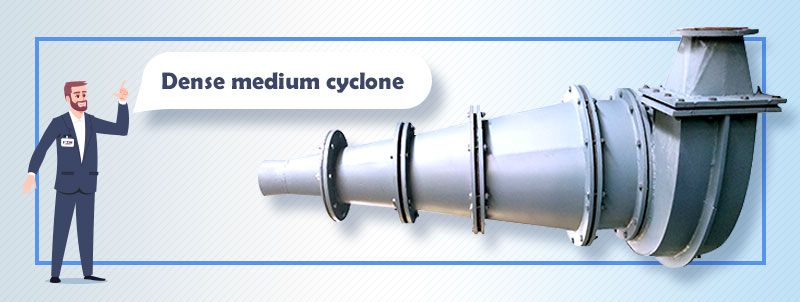
The dense medium cyclone (DMC) generally selects particle size between 50-0.3 mm.
What is the application of dense medium cyclones?
- Dense media cyclone has become the machine of choice in coal preparation plants to produce clean coal.
- Used in ore pre-selection, that is, to remove a large amount (40%-50%) of gangue under coarse-grained conditions.
- It is also used to purify industrial minerals such as iron ore, copper ore, gold ore, and pre-concentrate diamonds.
What are the pros and cons of dense medium cyclones?
Advantages
- The medium density can be prepared according to certain requirements, and the separation density can be precisely controlled, which can effectively separate minerals with small density differences.
- Large processing capacity per unit area, low beneficiation cost. Generally used in medium and large concentrators.
- Separation efficiency is generally 60%, and can be as high as 80%-90% in some cases.
Disadvantages
- High power consumption and quick wear and tear. When the particle size is large, the slurry feeding port of the cylinder and the sand sinking port of the cone are easy to wear.
- When the viscosity, concentration, and particle size composition of the slurry change, the separation particle size, and effect of the cyclone will change accordingly.
5. Centrifugal beneficiation
Centrifugal beneficiation mainly relies on centrifugal force to speed up the sedimentation and stratification of fine particles. Its suitable ore-feeding particle size is 0.074-0.01 mm, and it can effectively recover the ore slime of 0.037-0.019 mm.
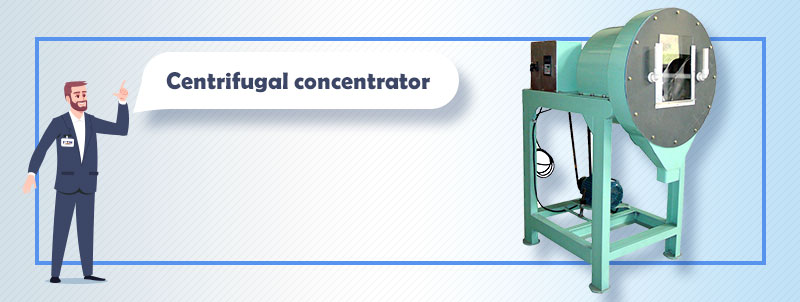
What is the application of centrifugal concentrators?
- The emergence of centrifugal concentrators enables the effective recovery of micro-fine ore particles.
- It is most suitable for recovering fine gold particles from alluvial gold, fine-grained rock gold, and quartz-type gold mines and separating tungsten and tin slime.
- A promising method for extracting fine particles of precious metals from loose ores and tailings.
What are the pros and cons of centrifugal concentrators?
Advantages
- Centrifugal concentrators utilize the centrifugal force to strengthen the gravity separation process and shorten the separation time.
- Centrifugal concentrators are more effective in the treatment of fine ore slime, and the recovery rate is even as high as about 90%.
- Compared with the shaking table, it occupies less area, has a large processing capacity, and saves power consumption.
Disadvantages
- Consumption of water and electricity is greater than that of flat chutes.
- The production process is an intermittent operation, and the ore cannot be fed continuously.
- The initial cost of purchasing a centrifugal concentrator may be higher compared to some other gravity concentrators.
You can read some FTM Machinery gravity concentration cases:
- What Are Gold Gravity Separation Equipment?
- How to Process Lead-Zinc Ore by Gravity Separators?
- Beneficiation Methods for 3 Kinds of Iron Ore
Conclusion
Gravity concentration is an attractive option in processing coal, beach sand, gold, iron, platinum, tin, tungsten ores, etc. Gravity separation, when applicable and effective, has the lowest operating costs compared to other beneficiation technologies. Since it does not require the use of chemicals and reagents, it also has minimal impact on the environment.
The most selected equipment in the concentrator is the shaking table = jigging machine > centrifugal concentrator > spiral chute = dense medium cyclone. Different gravity concentration equipment is designed to cater to different types of ore. You can contact our engineer, and we will formulate the most optimized equipment for you.


